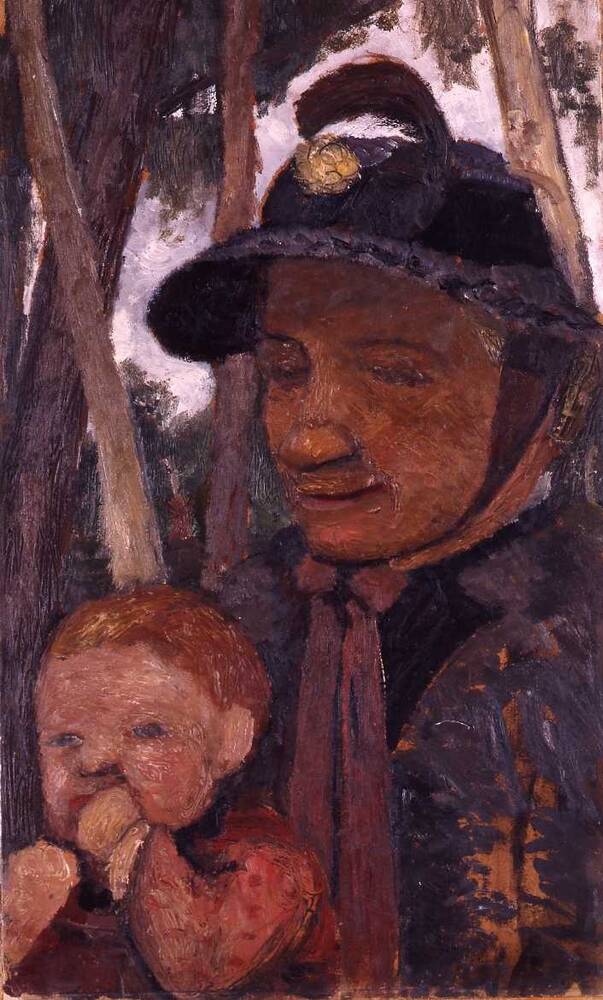“Living in the artists’ colony in the village of Worpswede, Paula Modersohn-Becker was surrounded by a moorland landscape shaped by the simple rhythms of farming life. The local women and children were important models in her work. She depicts this old woman in what is evidently traditional costume and carrying a toddler – and sets them both very close to the viewer! They almost fill the entire space, right to the edges of the frame – and so these two figures have a vibrant presence.”
For curator Birgit Dalbajewa, Old Woman with Hat is especially characteristic of Modersohn-Becker’s works. It was painted in 1905 in Worpswede near Bremen – when the artist had already been living in the village for seven years. Incidentally, although people sometimes think Paula Modersohn-Becker was from Bremen, she was actually born in Dresden in 1876 as Paula Becker. Her visits to the Dresden collections were an integral part of her early encounters with art.
In Worpswede, where she married the artist Otto Modersohn, she developed her own distinctive style of painting. Take a closer look at the old woman with her hat and the child. Modersohn-Becker has painted the figures in simplified, almost archaic forms, rendering them in a similar palette to the natural world around them. She wants to express the essential being of her figures, the woman caring for the child, the child’s keen attentiveness, the familiar security of their surroundings. With her unconventional painting technique, Paula Modersohn-Becker creates a lively surface – as curator Andreas Dehmer explains:
"Standing in front of the work, you can see just how expressive her painting style is, how she loosely juxtaposes the colours – and also, when necessary, does not hesitate to turn the brush around and use the handle rather than the bristles to scratch into the paint.”
Further Media
Women in Germany around 1900
Around 1900 in Germany, any woman hoping to work as an artist and live from their career choice had a hard time. Innovation and creativity were gendered male, and viewed purely as the reserve of men. As art critic Karl Scheffler wrote, women purely had...
“...a raison d`être as a model or a mother. By virtue of their gender incapable and unproductive, a woman can never become an artist – which, by definition, is ‘male’.”
Nonetheless, many women did launch careers as artists – even though they were not admitted to the courses at the state art academies. As curator Andreas Dehmer explains:
“One lesser-known fact in the history of so-called “women’s art” in the nineteenth century is just how many forms of organisations existed and how many women tried, in this way, to fight for their right to become artists as well –”
At their own cost, women attended private painting schools, took individual instruction, and founded associations to represent their interests. In 1919, with gender equality legally enshrined in the Weimar constitution, women were finally admitted to study at and graduate from state art academies. Nonetheless, women artists had also managed to gain a public profile previously:
“Even before 1919, Dresden had held a vast exhibition here in the Lipsius Building, showing works by over 400 women artists.”
The patron of the exhibition “Women’s Art” shown in 1912 was Princess Mathilde, Duchess of Saxony, herself a talented painter.
“Most importantly, the crucial thing about such rare exhibitions was the increased publicity for women artists in art journals and magazines. Just as with the art market now, the publicity triggered an interest among art dealers for the artists most often mentioned in these reports. Today, they all need to be rediscovered.”
- Location & Dating
- around 1905
- Material & Technique
- Oil on cardboard on hardboard
- Dimenions
- 64,5 x 40 cm (Katalogmaß 2010) 64,5 x 39,6 cm (Inventurmaß, 03.05.2010) 77,6 x 52,8 x 4,5 cm (Rahmenmaß, Tobias Lange, 03.05.2010)
- Museum
- Galerie Neue Meister
- Inventory number
- Leih-Nr. L 160
